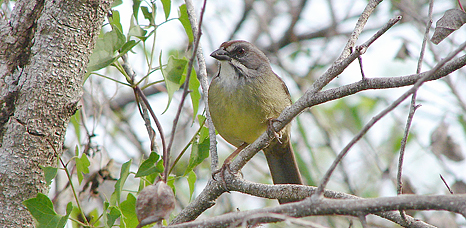Huw Morgan travelled on our 'Birding in Cuba' holiday and submitted this entry to our writing competition.
Zapata Sparrow by Arturo Kirkonell
Sleep came only fitfully that night as the mosquitoes menacingly announced their presence over the constant heaving clatter of the ancient Chinese-made air-conditioning unit. Too much sweet dark rum, and unfamiliar cocktails with unlikely names, had conspired against a night of easy slumber. Was I dreaming? Were all those noises in the darkness real or imagined? Would I be awake on time to catch the minibus that would take me to see the real object of my journey?
Near the hotel, during the hours of darkness, an army was on the march. Countless legions of land crabs had run the gauntlet of the road that had become an unwelcome obstruction between their maritime and terrestrial habitats. Part massacre, part amazing natural phenomenon, the scene that greeted us on our early morning journey was one of devastation. The sight of millions of crabs scrambling over each other in a desperate attempt to avoid being crushed under the wheels of vehicles that barely registered their presence.
Possessed of seemingly infinite patience and good humour, even our driver Jorge, impeccably dressed in jacket and tie, baulked at the prospect of taking his shiny new minibus up the muddy, potholed track that soon confronted us.
Having dismissed a variety of solutions that all seemed to involve unlikely ascents on to the back of variously dilapidated and visibly unsafe ancient trucks, optimistically held together with duct-tape and string, we settled on a compromise. A local farmer had been restoring an old 1950s American Chevrolet and he assured us that it was more than capable of coping with the rigours of the track that would lead us deep in to the marshy wilderness known as the Zapata Swamp.
These old American cars, long since destined for the scrap yards in their country of origin are determinedly and repeatedly renovated by ingenious Cubans who keep them going in the face of the many difficulties caused by the US trade embargo. Some simple adjustments quickly made, including the provision of front and back seats, allowed five intrepid souls to embark noisily in a plume of dark grey smoke in a vehicle originally designed for an entirely different purpose. Like a party of latter day gangsters, though armed only with telescopes, cameras and binoculars, we set off through the maze of sawgrass and silver saw palmetto that fringes the catfish-infested channels of this marshy wilderness. The afternoon heat and humidity was heightened by our close proximity. Crammed into the rear seat, the accompaniment of loud Cuban Jazz blaring from the limo’s ancient radio only served to heighten the surreal, cinematic quality of our journey.
Once we’d been dropped off, the sound of the Chevy’s retreating engine gave way to the reassuring hum of insects and the rustle of a soft warm breeze through the gently swaying grasses and ferns now surrounding us. Palm warblers, their bright yellow flanks readily identifiable, flitted silently in and out of the vegetation as if tantalising us with the prospect of what else might be there. A Turkey Vulture wheeled silently overhead, its bright vermillion head glistening obscenely in the strong sunlight. The still dark waters of the deep channels were occasionally rippled by the movement of a prowling catfish or lightly broken by some air bubbles possibly betraying the presence of a lurking crocodile. We scoured the scene silently until a small distinct shape could be seen moving through the cattail grass. There, firmly fixed in the sights of our optics, with its characteristic chestnut crown and black-and-white facial markings was the object of our odyssey – the Cabrera de la Cienaga, or Zapata Sparrow. With a flush of primrose yellow on its breast and abdomen this rare and endangered bird occasionally uttered a thin ‘seep’ as it clambered about in the scrub stopping only to gaze at us and listen to the sound of a cascade of camera shutters.
Time seemed to stand still as Black-cowled Oriole, Yellow-headed Warblers, Osprey, Anhinga and a distant Red-shouldered Blackbird drifted in and out of our view.
Our enraptured concentration was eventually broken by the now familiar sound of our returning transport. The deep thumping rhythm of the Chevy’s old diesel engine was now accompanied by the uncontrolled blaring of a horn announcing its presence to all and sundry, much to our amusement and the annoyance of the local fishermen.
The whole day seemed to encapsulate all that was fascinating and compelling about a land of such contrasts and contradictions. The generosity and openness of its people, the variety and fragility of its natural environment and its birdlife and the privilege of experiencing what can occur when the natural and man-made worlds collide made the experience of travelling in Cuba truly unforgettable.
Read more about our 'Birding in Cuba' holiday.



 Loading search...
Loading search...
